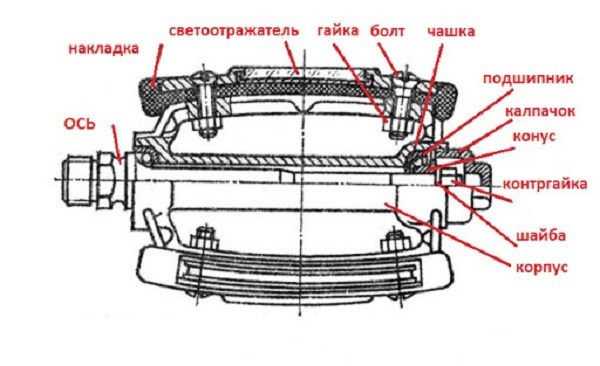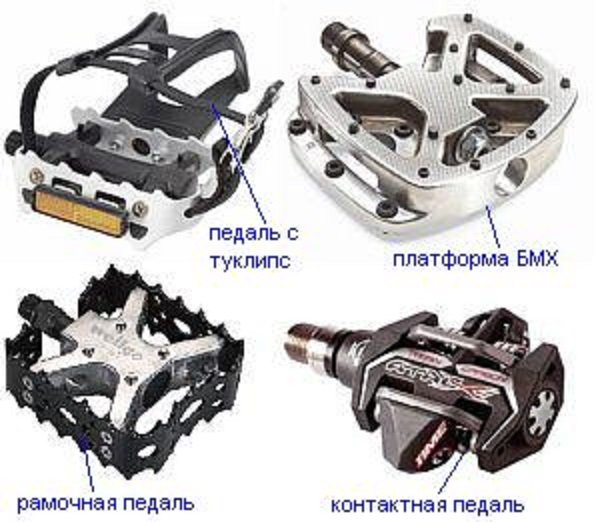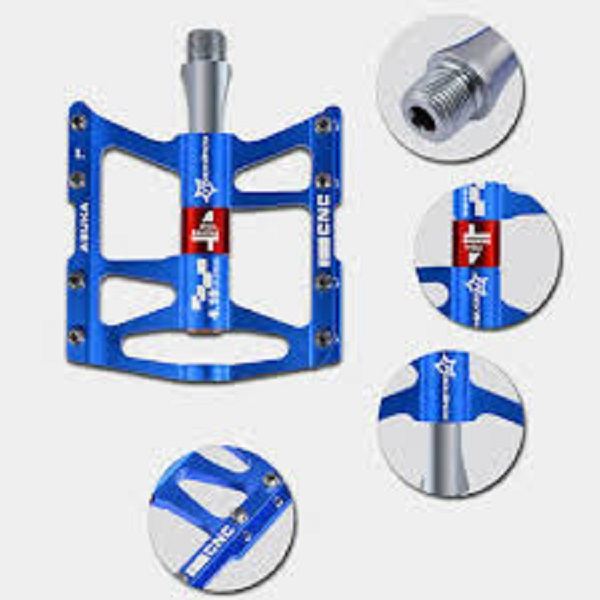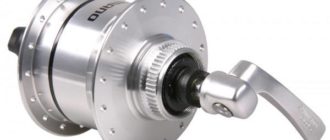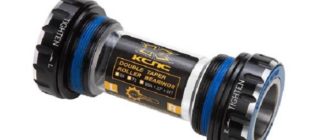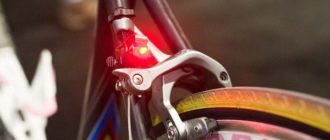Man has dreamed of flying since ancient times. The first to replace the absence of wings was the bicycle, which moves by means of a pair of pedals. From primitive to modern models, centuries have passed. The lever pressed by the cyclist’s foot has changed beyond recognition. Platforms, tuklips, walkers, road bikes–a dozen kinds are on the market today. Each has its own characteristics and features. To make the means of transportation made life interesting and comfortable, you need to know how to pick up pedals for a bicycle.
The device of bicycle pedals
The bicycle helps to travel long distances, participate in sports competitions, set records. Riding brings pleasure, if the vehicle is equipped with a comfortable seat and a reliable handlebar. But this is not enough. You need to pick up comfortable pedals and know their structure.
The design of the transmission consists of a body mounted on a rotating axle with bearings.
- Casing. The main part of the mechanism, on which the foot of the cyclist rests, provides all the work of the pedals. The material, shape, coloring, and design of the body are chosen by the manufacturers.
- Threaded axle. A shortened or lengthened device is screwed into the crank and provides rotation to the rear wheel through the chain. The length of the axle depends on the manufacturers who determine the weight of the part. The two symmetrical threads are denoted by Latin letters: L for left, R for right pedal.
- Bearings. Support the free rotation of the body around the axis. They can be industrial (the most reliable), bulk, with a cage.
- Frames (often aluminum) have different forms of protrusions. The decorative element is built into prefabricated pedal designs.
- Cataphot. Used in recreational models as a reflector on the roads.
- Spikes (integrated or variable). The device fixes the sole of the shoe to the body. Variable pedals are threaded, with which you can set the desired height of the spike.
- Mounting screws. Connect the body with the frame. An optional element, found only in folding models.
Interesting fact
Europeans are convinced: Carl Drez, a German baron and famous inventor, designed the first model of a bicycle (1817). However, the device was without pedals, and the rider had to compensate for this shortcoming with his feet. The invention was even called the “bone shaker”. According to the Russian version, the invention of the bicycle belongs to the Ural craftsman Yefim Artamonov, who made a design with two wheels back in 1800.
The claim that the first pedals on the front wheel of the bicycle were invented by the German Milius (1845) has been questioned. Historians have proved that the copyright belongs to Leonardo da Vinci. Back in the 15th century, the Italian artist and genius designer made a drawing of a vehicle with a steering wheel, wheels, chain and stars. The original drawing and the wooden bicycle with power pedals assembled from it are kept in the Boston Museum of Science. Professor Augusto Marinone confirmed the authenticity of the document. Although it is believed that the pedals were given to the world by Scottish blacksmith C. Macmillan (1840)
Varieties
Bicycle pedals come in expensive and cheap, professional and simple. Three categories are defined: manufacturing quality, riding style, type of cycling shoes (no shoe attachment, compatible with special sneakers, combined). Each group is represented by varieties that have their own characteristics.
| View | Features |
|---|---|
| Walking | The standard look is made of plastic The pedals split when used for a long time |
| Folding | The walking model variant is characterized by compactness, durability Pedals slide in and attach to the side of the bike |
| Contact | When choosing pedals for long-distance races, athletes use contacts (SPD or Look) It is easier to stand on two-sided devices if you do not have time to engage the pedals during the start of a ride |
| Semi-contact | A variation of the pedal device is designed for athletic tracks and city walks Mounted on only one side of the bicycle pedal surface |
| Highway | Pedals with rigid mounts are used on road bikes Design keeps your foot firmly in place Special spiked and non-treaded shoes are used |
| Toclips | “Collector” of contact devices has no fasteners, which have replaced the straps The load is on the platform The model is comfortable for normal riding, but not suitable for people with large feet |
| Platforms (or “stompboxes”) | Model is designed for increased load when riding on mountainous terrain Pedals for mountain biking are used for aggressive riding styles Made of steel or titanium |
Pedal sizes
Standard and large pedal sizes must be matched to the connecting rods. City (walking) models are factory-fitted. Pedals indicate a size of 9/16″ or 1/2″, which will fit any bicycle. There is no binding to the cyclist’s shoe on the tuklips. The selected pedal must match the foot size.
There is a wide body that is used to increase the contact area of the feet and pedals. With the contact model, the bicycle shoes are attached to the body and fit tightly around the foot. Some bikers prefer to pedal a size larger so that the foot does not interfere with anything. According to these features choose the size of the pedals. Children’s platforms are made smaller to fit a child’s foot.
Materials and colors of pedals
This important component of the bicycle design experiences constant increased loads: the rider’s weight, torque, overload when performing jumps and tricks, impacts when the cyclist falls. Therefore, the pedals are made with an optimal margin of safety, which is achieved by using different materials.
The axle is made of durable metal. The platform, which used to be made of rubberized tubes and metal plates, is now represented by plastic and aluminum alloy (for entry-level and mid-price bikes). On “serious riding” bikes put platforms made of metal. Toclips are also made of plastic or metal, and leather or nylon is used for the strap. To prevent the cyclist’s feet from slipping, rubber pads are installed. Contact pedals are equipped with a chrome-molybdenum axis, in which the light-retracting elements are built in. Pedals of mountain bikes, designed for aggressive riding, are made of steel or titanium.
The choice of the modern cyclist depends on aesthetic preferences. Therefore, manufacturers are trying to emphasize the design of pedals in red, yellow, green and colored inserts. For example, in the manufacture of Wellgo models use black, white or matte shade. Often there is a bright company label on the pedals. The degree of fixation of the spikes is determined by the color scheme:
- Red – the toughest spikes, used to maximize the efforts of professional athletes;
- blue – means 2 degrees of shifting of the foot (for comfortable riding);
- yellow – 6 degrees of shear (ideal for beginners and recreational riders).
Recommendations for selection
Modern models are made according to the principle: maximum service life, reliability, minimum costs for repairs. Advice from professionals will help to answer the question: how to choose pedals for a bicycle with an optimal margin of safety.
- Determine the purpose of the device.
Plastic body is designed for riding in the city. Contact pedals without platforms require special shoes and are used in Cross-country—what-it-is–nuances. Designs with powerful spikes on the platform are suitable for extreme riding. General purpose pedals should include metal and composite platforms.
A composite platform is suitable for everyday riding. The polymer product is characterized by a long lifespan, low weight, and affordable price. For example, TREK pedals can withstand five seasons of use.
- Choose the right material.
It’s good if the pedals are made of metal (titanium, steel, aluminum). Plastic construction often breaks at the most inopportune moment. Aluminum device withstands increased loads and does not suffer from shocks.
- Requirements for the axle.
The main element of pedals should choose from chrome steel. The detail is used even on the most expensive bikes, designed for professionals. Normal metal or plastic is suitable for children’s or teenage models.
- The choice of bearings.
Bulk nodes are put on simple bicycles, which are not adapted to aggressive riding and increased loads. The second type (wash) is made by a special technology: resistant to mechanical damage, used in pedals of high value.
- Relief.
Models with spikes protect the cyclist’s legs from slipping, reduce the risk of falling, ensure the safety of the rider.
- Built-in cataphot.
It is worth giving preference to designs with a reflective element. This will help avoid accidents on dark roads. Drivers riding behind the car can immediately see the cyclist.
- Check the safety of the clutch and release.
Spikes should be mounted on the pedals, not on the shoe, and match the terminals exactly. Consider the color of the cleats when shopping.
- Purchase cycling shoes that are compatible with the pedals.
Contact sneakers should have holes that match the type of cleats. Often compatible bindings and pedals are sold together. But you can also buy them separately in case you need to replace them from wear and tear.
Popular Models
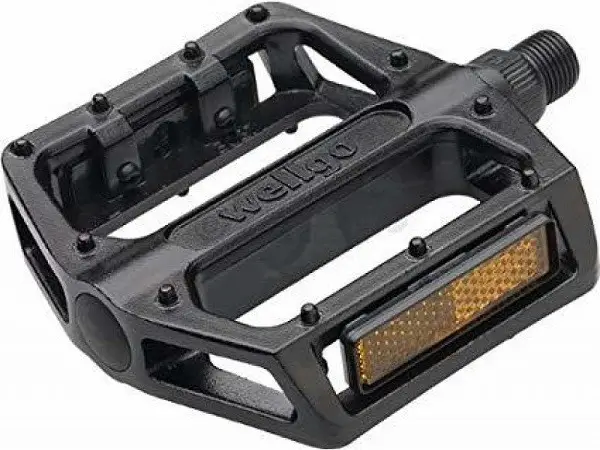
Wellgo B087
Experts have identified the best pedal models, their features are presented in the table.
| Model | Features | Average price (rubles) |
|---|---|---|
| Wellgo B123 | Inexpensive option for everyday riding Wide platform made of plastic compound Robust spikes that hold the cyclist’s foot in place Bulk bearings Sturdy chrome-moly axle |
550 |
| Wellgo B197 | Redesigned pad shape Rugged body does not slip when wet, holds shoe sole firmly Little wear and tear on cleats Easy assembly (#6 wrench can be used) |
650 |
| LU-313 | Aluminum housing Sturdy, wide pedals Chromium-molybdenum core to ensure structural reliability in case of shocks or jumps Supports a considerable weight of the rider (from 120 kg and above) |
1300 |
| BBB Trail Ride | Designed for hard city riding and touring Hybrid bearings Milled axle with chromium-molybdenum steel Retrofitted reflectors Colorful design |
1500 |
| Wellgo B087 | Large dimensions Rugged device Aluminum platform with molded protrusions High quality axle Interchangeable cleats |
2400 |
| Wellgo LU-A52 | Suitable for extreme sports Eight interchangeable spikes on both sides on wide pads Reliable grip on the shoe Designed for size 44 to 46 feet |
2500 |
| Wellgo B223BP | Pedal model used for BMX style riding Durable clear polymer backing Stress and shock resistant High quality plastic, robust construction |
2800 |
| Exustar BMX | German stompers with reduced weight Robust closed construction The material is treated with special technology when the base is made Long life |
3000 |
| Shimano GR500 | Model from a Japanese manufacturer Pedals made of quality aluminum alloy Platforms designed for extreme riding Robust axle designed to withstand extreme racing and a rider weight of over 150 kg |
3500 |
| BBB CoolRide BPD-36 | Colored pedals in a slim body Chromium-molybdenum axle Maximum shoe hook Ten reliable spikes Closed design 495 g product weight |
3700 |
| Wellgo MG-1 | Unique design Rugged platform Interchangeable spike set Maximum grip in all conditions Additional protection system against the weather |
5400 |
| Shimano Deore XT M8040 | Manufactured by Shimano High quality material used Reliable and stable platform Chromium-molybdenum axle Hardened steel spikes Attractive design |
7800 |
| Mavic Crossmax XL Pro | Top-rated models The device is designed for endurance riding on rough terrain Easy unhooking from the contact lock Increased efficiency when pedaling Extra water and dust protection |
11000 |
| Shimano SAINT | Used by top professionals Pedals without flaws are considered the benchmark for manufacturers Increased ruggedness and reliability of design Maximum stability Long service life Colorful design |
14000 |
Conclusion
The results of the poll about the greatest invention of the XIX-XX centuries, conducted by the British in 2005 surprised even the organizers. By the quantity of collected votes the bicycle overtook all the inventions taken together (even the Internet). On a two-wheeled mechanism with reliable pedals, a man managed to reach a speed of 300 km per hour. Knowing about the device of pedals and popular models, you can safely go to the store for an update for your bike.

